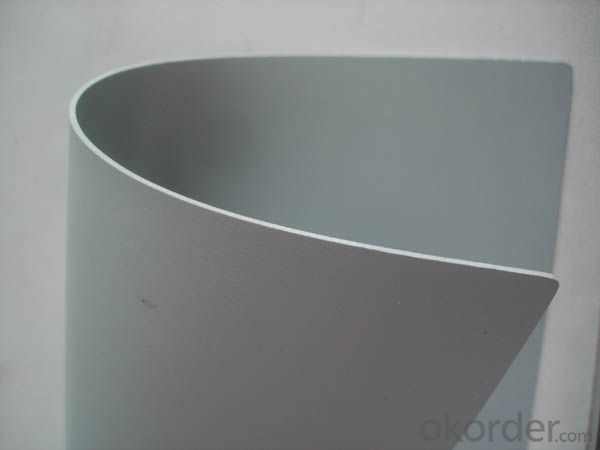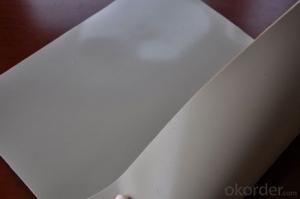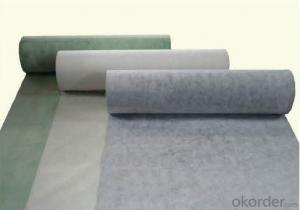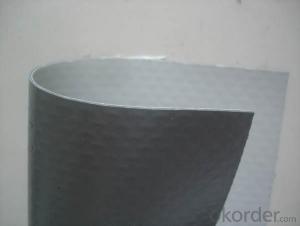PVC Laminated Roofing and Waterproofing Membrane
- Loading Port:
- China main port
- Payment Terms:
- TT OR LC
- Min Order Qty:
- 5000 m²
- Supply Capability:
- 100000 m²/month
OKorder Service Pledge
OKorder Financial Service
You Might Also Like
PVC membrane Product Description:
PVC waterproofing roofing membrane are based upon Polyvinyl Chloride Resin
with other additives to provide flexibility and stability. It gives a good performance of
anti-oxidant, absorbent of ultraviolet light, plasticizer and plastic filling agent.
Product Features:
1.High Tensile Strength
2.Waterproof,Corrosion-Resistant
3.Good Low Tempreture resistance
4.High Barrier Property
PVC membrane Product Specification:
Material: PE
Weight: 45-350g/m2
Thickness: 3mm
Style: Plain
Coated Type:PE Laminated
FAQ of PVC Waterproofing Membrane
a.Can we get some samples before place order?
Answer: We can send the free samples to you by freight collect.
b.How many years can your PVC membrane guarantee?
Answer: We will guarantee the quality for 5 years at least.
c.Which countries you ever export the product?
Answer: We export the PVC membrane to South Africa, Middle east and even European countries.

- Q:Can waterproofing membranes be used on wood surfaces?
- Yes, waterproofing membranes can be used on wood surfaces. Waterproofing membranes are versatile products that can be applied to a variety of materials, including wood. They are designed to create a protective barrier that prevents water from penetrating the surface, thereby preventing damage caused by moisture, such as rotting, warping, or mold growth. When applied correctly, waterproofing membranes can effectively seal wood surfaces, making them resistant to water absorption and increasing their durability and lifespan. It is important to choose a waterproofing membrane that is specifically formulated for wood applications and follow the manufacturer's instructions for proper application and maintenance.
- Q:Can a waterproofing membrane prevent mold and mildew growth?
- Yes, a waterproofing membrane can help prevent mold and mildew growth. Mold and mildew thrive in damp and moist environments, and waterproofing membranes create a barrier that prevents water from seeping into the underlying surfaces. By keeping the area dry, the membrane reduces the conditions necessary for mold and mildew to grow. Additionally, some waterproofing membranes are designed with antimicrobial properties, which further inhibit the growth of mold and mildew. However, it is important to note that while a waterproofing membrane can help prevent mold and mildew growth, it is not a foolproof solution. Proper ventilation and maintenance are also crucial in preventing these issues.
- Q:What is the meaning of "channel" and "layer" in the practice of polymer waterproofing membrane?
- In addition, the two did not meet the required thickness of the waterproof layer, according to certain requirements for laminated composite, two waterproof layer can be considered a waterproof. Such as 1.2mm polyurethane + 1.2mm self-adhesive coil (laminated construction rather than separate), can be used as a waterproof, although with two kinds of materials to do a two-story waterproof, and can not be considered two waterproof. The thickness of the laminated composite waterproofing layer can be thinned, and its provisions may be reflected in the new "roofing engineering technical specification" to be published.
- Q:Are waterproofing membranes resistant to saltwater corrosion?
- Waterproofing membranes are generally resistant to saltwater corrosion, as they are designed to protect against water and moisture, including saltwater exposure. These membranes are typically made from corrosion-resistant materials like synthetic polymers or bitumen, which can withstand the corrosive effects of saltwater. Furthermore, additives or coatings are often used to reinforce their resistance to corrosion. However, it is important to consider that the level of resistance may vary depending on the specific type and quality of the membrane. Therefore, it is recommended to consult professionals or manufacturers to ensure that the chosen waterproofing membrane is suitable for saltwater environments.
- Q:Can a waterproofing membrane be used for pond or pool applications?
- Certainly! A waterproofing membrane is suitable for both pond and pool applications. Its main purpose is to create a barrier that prevents water from penetrating, making it an excellent choice for sealing ponds and pools. These membranes are typically made from synthetic materials like PVC, EPDM, or TPO, all of which have high resistance to water and UV rays. They come in different thicknesses and can be tailored to fit the specific dimensions of the pond or pool. Moreover, waterproofing membranes are incredibly durable and flexible, allowing them to withstand continuous exposure to water and the movement of the underlying substrate. In summary, utilizing a waterproofing membrane for pond or pool applications helps avoid leaks, extends the lifespan of the structure, and guarantees a safe and enjoyable water environment.
- Q:Can a waterproofing membrane be used in conjunction with green building practices?
- Certainly, a waterproofing membrane can be utilized alongside green building practices. In actuality, integrating a waterproofing membrane into the construction of a green building can greatly enhance its overall sustainability and efficiency. One of the fundamental principles of green building practices is to maximize energy efficiency and decrease the environmental impact of a structure. By installing a waterproofing membrane, the building's outer covering can be shielded from moisture intrusion, thereby preventing water damage and potential mold growth. This, in turn, aids in preserving the structural integrity of the building, reducing the necessity for costly repairs and replacements, which can consume resources and generate waste. Moreover, a waterproofing membrane can contribute to improved indoor air quality. By preventing water infiltration, it assists in creating a dry and healthy living or working environment, minimizing the risk of respiratory problems and other health issues associated with dampness. Furthermore, a waterproofing membrane can enhance the energy efficiency of a building. By preventing water from seeping into the walls or foundation, it lessens the potential for heat loss through moisture evaporation, thus reducing the energy required for heating and cooling. This can lead to decreased energy consumption and lower carbon emissions, aligning with the objectives of green building practices. However, it is crucial to select a waterproofing membrane that is environmentally friendly and compliant with green building standards. Seek out membranes that are crafted from recycled or sustainable materials and possess low VOC (volatile organic compound) content. Additionally, consider opting for a membrane that is designed for longevity and durability, as this can further minimize the environmental impact by reducing the need for replacement over time. In conclusion, a waterproofing membrane can be an invaluable addition to any green building endeavor. It serves to safeguard the building envelope, enhance indoor air quality, and improve energy efficiency. By choosing an environmentally friendly membrane, the overall sustainability of the building can be further enhanced.
- Q:Can a waterproofing membrane be used for bridges and overpasses?
- Yes, a waterproofing membrane can be used for bridges and overpasses. Waterproofing membranes are commonly used in infrastructure projects to protect the structures from water damage and extend their lifespan. They create a barrier against moisture, preventing water infiltration and protecting the underlying materials from corrosion and deterioration. By applying a waterproofing membrane to bridges and overpasses, it helps ensure their durability and structural integrity.
- Q:What is a waterproofing membrane?
- A waterproofing membrane is a thin layer or sheet of material that is applied to a surface to prevent the passage of water or moisture. It is commonly used in construction, particularly in areas where water infiltration is a concern, such as roofs, basements, and bathrooms. The membrane acts as a barrier, preventing water from seeping through and causing damage to the underlying structure. It can be made from various materials, including rubber, bitumen, or synthetic polymers, and is typically applied in multiple layers to enhance its effectiveness. Waterproofing membranes are designed to be flexible, durable, and resistant to environmental factors such as UV radiation and temperature fluctuations. They are an essential component in ensuring the longevity and integrity of buildings by keeping them dry and protected from water-related issues like leaks, mold, and deterioration.
- Q:Are there any specific considerations for installing a waterproofing membrane on concrete surfaces?
- Yes, there are several specific considerations for installing a waterproofing membrane on concrete surfaces. Firstly, it is important to ensure that the concrete surface is clean, dry, and free from any loose materials, oil, grease, or other contaminants. Any dirt or debris on the surface can prevent proper adhesion of the waterproofing membrane, compromising its effectiveness. Secondly, it is crucial to inspect the concrete surface for any cracks, spalling, or other damage. These defects should be repaired prior to installing the waterproofing membrane, as they can allow water to penetrate through the membrane and compromise its ability to protect the concrete. Additionally, the type of waterproofing membrane chosen should be suitable for the specific conditions and requirements of the project. There are various types of membranes available, such as sheet membranes, liquid-applied membranes, or cementitious coatings. Each type has different application methods, durability, flexibility, and resistance to various substances, so it is important to select the appropriate membrane for the specific concrete surface and its intended use. Furthermore, the installation of the waterproofing membrane should be carried out in accordance with the manufacturer's instructions. This includes applying the membrane at the recommended thickness, ensuring proper overlap and adhesion of the membrane seams, and using any recommended primers or adhesives. Lastly, it is important to consider the long-term maintenance and durability of the waterproofing membrane. Regular inspections, maintenance, and repairs should be conducted to ensure the membrane remains intact and effective in preventing water penetration.
- Q:Is a waterproofing membrane resistant to UV radiation?
- Typically, a waterproofing membrane is resistant to UV radiation. Most manufacturers design these membranes to be durable and long-lasting, ensuring they can withstand exposure to UV rays. Over time, UV radiation from the sun can cause degradation and damage to various materials, including waterproofing membranes. To combat this, manufacturers often include UV stabilizers and additives in the membrane's composition. These additives prevent the breakdown of the membrane's structure, allowing it to remain effective in preventing water infiltration and maintaining its performance for an extended period, even when exposed to direct sunlight. Some waterproofing membranes may also have a protective layer or coating that offers extra UV resistance. To understand the specific UV resistance capabilities of a particular waterproofing membrane, it is advisable to consult the manufacturer's specifications and guidelines.
1. Manufacturer Overview |
|
|---|---|
| Location | |
| Year Established | |
| Annual Output Value | |
| Main Markets | |
| Company Certifications | |
2. Manufacturer Certificates |
|
|---|---|
| a) Certification Name | |
| Range | |
| Reference | |
| Validity Period | |
3. Manufacturer Capability |
|
|---|---|
| a)Trade Capacity | |
| Nearest Port | |
| Export Percentage | |
| No.of Employees in Trade Department | |
| Language Spoken: | |
| b)Factory Information | |
| Factory Size: | |
| No. of Production Lines | |
| Contract Manufacturing | |
| Product Price Range | |
Send your message to us
PVC Laminated Roofing and Waterproofing Membrane
- Loading Port:
- China main port
- Payment Terms:
- TT OR LC
- Min Order Qty:
- 5000 m²
- Supply Capability:
- 100000 m²/month
OKorder Service Pledge
OKorder Financial Service
Similar products
New products
Hot products
Related keywords




























